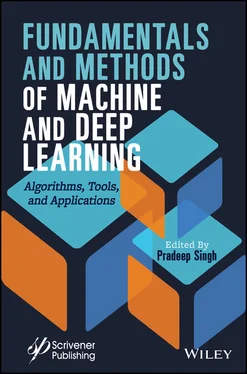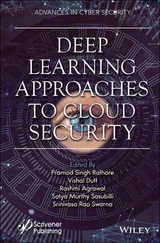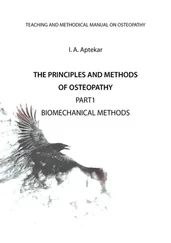Pradeep Singh - Fundamentals and Methods of Machine and Deep Learning
Здесь есть возможность читать онлайн «Pradeep Singh - Fundamentals and Methods of Machine and Deep Learning» — ознакомительный отрывок электронной книги совершенно бесплатно, а после прочтения отрывка купить полную версию. В некоторых случаях можно слушать аудио, скачать через торрент в формате fb2 и присутствует краткое содержание. Жанр: unrecognised, на английском языке. Описание произведения, (предисловие) а так же отзывы посетителей доступны на портале библиотеки ЛибКат.
- Название:Fundamentals and Methods of Machine and Deep Learning
- Автор:
- Жанр:
- Год:неизвестен
- ISBN:нет данных
- Рейтинг книги:5 / 5. Голосов: 1
-
Избранное:Добавить в избранное
- Отзывы:
-
Ваша оценка:
- 100
- 1
- 2
- 3
- 4
- 5
Fundamentals and Methods of Machine and Deep Learning: краткое содержание, описание и аннотация
Предлагаем к чтению аннотацию, описание, краткое содержание или предисловие (зависит от того, что написал сам автор книги «Fundamentals and Methods of Machine and Deep Learning»). Если вы не нашли необходимую информацию о книге — напишите в комментариях, мы постараемся отыскать её.
The book provides a practical approach by explaining the concepts of machine learning and deep learning algorithms, evaluation of methodology advances, and algorithm demonstrations with applications.
Audience
Fundamentals and Methods of Machine and Deep Learning — читать онлайн ознакомительный отрывок
Ниже представлен текст книги, разбитый по страницам. Система сохранения места последней прочитанной страницы, позволяет с удобством читать онлайн бесплатно книгу «Fundamentals and Methods of Machine and Deep Learning», без необходимости каждый раз заново искать на чём Вы остановились. Поставьте закладку, и сможете в любой момент перейти на страницу, на которой закончили чтение.
Интервал:
Закладка:
Table of Contents
1 Cover
2 Title page
3 Copyright
4 Preface
5 1 Supervised Machine Learning: Algorithms and Applications 1.1 History 1.2 Introduction 1.3 Supervised Learning 1.4 Linear Regression (LR) 1.5 Logistic Regression 1.6 Support Vector Machine (SVM) 1.7 Decision Tree 1.8 Machine Learning Applications in Daily Life 1.9 Conclusion References
6 2 Zonotic Diseases Detection Using Ensemble Machine Learning Algorithms 2.1 Introduction 2.2 Bayes Optimal Classifier 2.3 Bootstrap Aggregating (Bagging) 2.4 Bayesian Model Averaging (BMA) 2.5 Bayesian Classifier Combination (BCC) 2.6 Bucket of Models 2.7 Stacking 2.8 Efficiency Analysis 2.9 Conclusion References
7 3 Model Evaluation 3.1 Introduction 3.2 Model Evaluation 3.3 Metric Used in Regression Model 3.4 Confusion Metrics 3.5 Correlation 3.6 Natural Language Processing (NLP) 3.7 Additional Metrics 3.8 Summary of Metric Derived from Confusion Metric 3.9 Metric Usage 3.10 Pro and Cons of Metrics 3.11 Conclusion References
8 4 Analysis of M-SEIR and LSTM Models for the Prediction of COVID-19 Using RMSLE 4.1 Introduction 4.2 Survey of Models 4.3 Methodology 4.4 Experimental Results 4.5 Conclusion 4.6 Future Work References
9 5 The Significance of Feature Selection Techniques in Machine Learning 5.1 Introduction 5.2 Significance of Pre-Processing 5.3 Machine Learning System 5.4 Feature Extraction Methods 5.5 Feature Selection 5.6 Merits and Demerits of Feature Selection 5.7 Conclusion References
10 6 Use of Machine Learning and Deep Learning in Healthcare—A Review on Disease Prediction System 6.1 Introduction to Healthcare System 6.2 Causes for the Failure of the Healthcare System 6.3 Artificial Intelligence and Healthcare System for Predicting Diseases 6.4 Facts Responsible for Delay in Predicting the Defects 6.5 Pre-Treatment Analysis and Monitoring 6.6 Post-Treatment Analysis and Monitoring 6.7 Application of ML and DL 6.8 Challenges and Future of Healthcare Systems Based on ML and DL 6.9 Conclusion References
11 7 Detection of Diabetic Retinopathy Using Ensemble Learning Techniques 7.1 Introduction 7.2 Related Work 7.3 Methodology 7.4 Proposed Models 7.5 Experimental Results and Analysis 7.6 Conclusion References
12 8 Machine Learning and Deep Learning for Medical Analysis—A Case Study on Heart Disease Data 8.1 Introduction 8.2 Related Works 8.3 Data Pre-Processing 8.4 Feature Selection 8.5 ML Classifiers Techniques 8.6 Hyperparameter Tuning 8.7 Dataset Description 8.8 Experiments and Results 8.9 Analysis 8.10 Conclusion References
13 9 A Novel Convolutional Neural Network Model to Predict Software Defects 9.1 Introduction 9.2 Related Works 9.3 Theoretical Background 9.4 Experimental Setup 9.5 Conclusion and Future Scope References
14 10 Predictive Analysis of Online Television Videos Using Machine Learning Algorithms 10.1 Introduction 10.2 Proposed Framework 10.3 Feature Selection 10.4 Classification 10.5 Online Incremental Learning 10.6 Results and Discussion 10.7 Conclusion References
15 11 A Combinational Deep Learning Approach to Visually Evoked EEG-Based Image Classification 11.1 Introduction 11.2 Literature Review 11.3 Methodology 11.4 Result and Discussion 11.5 Conclusion References
16 12 Application of Machine Learning Algorithms With Balancing Techniques for Credit Card Fraud Detection: A Comparative Analysis 12.1 Introduction 12.2 Methods and Techniques 12.3 Results and Discussion 12.4 Conclusions References
17 13 Crack Detection in Civil Structures Using Deep Learning 13.1 Introduction 13.2 Related Work 13.3 Infrared Thermal Imaging Detection Method 13.4 Crack Detection Using CNN 13.5 Results and Discussion 13.6 Conclusion References
18 14 Measuring Urban Sprawl Using Machine Learning 14.1 Introduction 14.2 Literature Survey 14.3 Remotely Sensed Images 14.4 Feature Selection 14.5 Classification Using Machine Learning Algorithms 14.6 Results 14.7 Discussion and Conclusion Acknowledgements References
19 15 Application of Deep Learning Algorithms in Medical Image Processing: A Survey 15.1 Introduction 15.2 Overview of Deep Learning Algorithms 15.3 Overview of Medical Images 15.4 Scheme of Medical Image Processing 15.5 Anatomy-Wise Medical Image Processing With Deep Learning 15.6 Conclusion References
20 16 Simulation of Self-Driving Cars Using Deep Learning 16.1 Introduction 16.2 Methodology 16.3 Hardware Platform 16.4 Related Work 16.5 Pre-Processing 16.6 Model 16.7 Experiments 16.8 Results 16.9 Conclusion References
21 17 Assistive Technologies for Visual, Hearing, and Speech Impairments: Machine Learning and Deep Learning Solutions 17.1 Introduction 17.2 Visual Impairment 17.3 Verbal and Hearing Impairment 17.4 Conclusion and Future Scope References
22 18 Case Studies: Deep Learning in Remote Sensing 18.1 Introduction 18.2 Need for Deep Learning in Remote Sensing 18.3 Deep Neural Networks for Interpreting Earth Observation Data 18.4 Hybrid Architectures for Multi-Sensor Data Processing 18.5 Conclusion References
23 Index
24 End User License Agreement
Guide
1 Cover
2 Table of Contents
3 Title page
4 Copyright
5 Preface
6 Begin Reading
7 Index
8 End User License Agreement
List of Illustrations
1 Chapter 1Figure 1.1 Linear regression [3].Figure 1.2 Height vs. weight graph [6].Figure 1.3 Logistic regression [3].Figure 1.4 SVM [11].Figure 1.5 Decision tree.
2 Chapter 2Figure 2.1 A high-level representation of Bayes optimal classifier.Figure 2.2 A high-level representation of Bootstrap aggregating.Figure 2.3 A high-level representation of Bayesian model averaging (BMA).Figure 2.4 A high-level representation of Bayesian classifier combination (BCC).Figure 2.5 A high-level representation of bucket of models.Figure 2.6 A high-level representation of stacking.
3 Chapter 3Figure 3.1 ML/DL model deployment process.Figure 3.2 Residual.Figure 3.3 Confusion metric.Figure 3.4 Confusion metric interpretation.Figure 3.5 Metric derived from confusion metric.Figure 3.6 Precision-recall trade-off.Figure 3.7 AUC-ROC curve.Figure 3.8 Precision-recall curve.Figure 3.9 Confusion metric example.Figure 3.10 Cosine similarity projection.Figure 3.11 (a) Cosine similarity. (b) Soft cosine similarity.Figure 3.12 Intersection and union of two sets A and B.Figure 3.13 Confusion metric.
4 Chapter 4Figure 4.1 Cases in Karnataka, India.Figure 4.2 Cases trend in Karnataka, India.Figure 4.3 Modified SEIR.Figure 4.4 LSTM cell.Figure 4.5 (a) Arrangement of data set in 3D tensor. (b) Mapping of the 3D and 2...Figure 4.6 RMSLE value vs. number of epochs.Figure 4.7 Cases in Karnataka.Figure 4.8 SEIR Model fit for test cases.Figure 4.9 Cases predicted for next 10 days.Figure 4.10 Testing results.Figure 4.11 Next 10 days Prediction using LSTM model.Figure 4.12 Prediction error curve.Figure 4.13 Prediction error and RMSLE curve.
5 Chapter 5Figure 5.1 Classification of feature extraction methods.
6 Chapter 6Figure 6.1 Relationship between AI, ML, and DL.Figure 6.2 Image segmentation process flow.Figure 6.3 The visual representation of clinical data generation to natural lang...
7 Chapter 7Figure 7.1 Extraction of exudates.Figure 7.2 Extraction of blood vessels.Figure 7.3 Extraction of microaneurysms.Figure 7.4 Extraction of hemorrhages.Figure 7.5 Working of AdaBoost model.Figure 7.6 Working of AdaNaive model.Figure 7.7 Working of AdaSVM model.Figure 7.8 Working of AdaForest model.Figure 7.9 Representative retinal images of DR in their order of increasing seve...Figure 7.10 Comparison of classifiers using ROC curve (Binary classification).Figure 7.11 Comparison of classifiers (Binary Classification).Figure 7.12 Comparison of classifiers (Multi Classification).
8 Chapter 8Figure 8.1 Workflow model of proposed system.Figure 8.2 Architecture of proposed system.Figure 8.3 Original dataset distribution.Figure 8.4 Resampling using SMOTE.Figure 8.5 Target class distribution.Figure 8.6 Resampled distribution applying SMOTE.Figure 8.7 Feature ranking using Extra tree classifier.Figure 8.8 p-values of the features.Figure 8.9 Performance evaluation of models under study 1 with dataset size = 1,...Figure 8.10 Performance evaluation of models under study 2 with data size = 1,00...Figure 8.11 Performance evaluation of models under study 3 With dataset size = 1...Figure 8.12 Correlation between follow-up time and death event.Figure 8.13 Performance evaluation of models on different classifiers.Figure 8.14 Performance evaluation of models on dataset size = 508.Figure 8.15 Performance evaluation of models on dataset size = 1,000.
Читать дальшеИнтервал:
Закладка:
Похожие книги на «Fundamentals and Methods of Machine and Deep Learning»
Представляем Вашему вниманию похожие книги на «Fundamentals and Methods of Machine and Deep Learning» списком для выбора. Мы отобрали схожую по названию и смыслу литературу в надежде предоставить читателям больше вариантов отыскать новые, интересные, ещё непрочитанные произведения.
Обсуждение, отзывы о книге «Fundamentals and Methods of Machine and Deep Learning» и просто собственные мнения читателей. Оставьте ваши комментарии, напишите, что Вы думаете о произведении, его смысле или главных героях. Укажите что конкретно понравилось, а что нет, и почему Вы так считаете.












